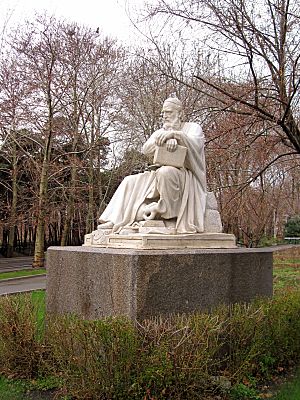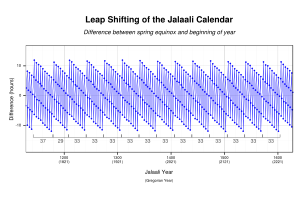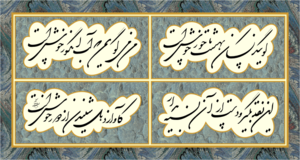Omar Khayyám facts for kids
Quick facts for kids
Hakim
Omar Khayyam
عمر خیّام |
|
|---|---|

Statue of Omar Khayyam by Abolhassan Sadighi
|
|
| Born | 18 May 1048 |
| Died | 4 December 1131 (aged 83) Nishapur, Khorasan, Seljuk Empire
|
| Academic background | |
| Influences | Avicenna, al-Khwārizmī, Euclid, Apollonius of Perge |
| Academic work | |
| Main interests | Mathematics (medieval Islamic), astronomy, Persian philosophy, Persian poetry |
| Influenced | Tusi, Al-Khazini, Nizami Aruzi of Samarcand, Hafez, Sadegh Hedayat, André Gide, John Wallis, Saccheri, Edward FitzGerald, Maurice Bouchor, Henri Cazalis, Jean Chapelain, Amin Maalouf |
Omar Khayyam (born May 18, 1048 – died December 4, 1131) was a brilliant polymath, which means he was an expert in many different fields! He was famous for his amazing work in mathematics, astronomy, philosophy, and Persian poetry.
He was born in Nishapur, which was an important city in the Seljuk Empire. Omar Khayyam lived during the time of the Seljuk dynasty and the First Crusade.
As a mathematician, he is best known for solving cubic equations (equations with a variable raised to the power of three). He found clever ways to solve these using geometric shapes. He also helped us understand the parallel axiom in geometry.
As an astronomer, he was incredibly accurate. He calculated how long a solar year is with amazing precision. He also designed the Jalali calendar, a solar calendar that was so good, it's still the basis for the Persian calendar used today, almost a thousand years later!
Many poems are believed to have been written by Omar Khayyam. These poems are called quatrains (or rubāʿiyāt). His poetry became very popular in the English-speaking world thanks to a translation by Edward FitzGerald in 1859, called Rubaiyat of Omar Khayyam.
Contents
Life of Omar Khayyam
Omar Khayyam was born in Nishapur in 1048. His family was Persian. People often called him "Omar Khayyam." The name Khayyam means "tent-maker" in Arabic, so some people think his family might have made tents.
Historians have used details from his horoscope to figure out his exact birth date: May 18, 1048.
Young Omar grew up in Nishapur, a big city in the Seljuk Empire. His teachers quickly saw how smart he was. They sent him to study with Imam Muwaffaq Nishaburi, a famous teacher who taught children of important families. Omar became good friends with him. He also learned from a mathematician named Abu Hassan Bahmanyar bin Marzban.
After studying science, philosophy, mathematics, and astronomy in Nishapur, Omar traveled to Bukhara around 1068. He spent time in its famous library. Around 1070, he moved to Samarkand. There, he began writing his important book on algebra. The ruler of Samarkand, Shams al-Mulk Nasr, respected Omar greatly and even invited him to sit on his throne!
In 1074, Omar Khayyam was invited to work for Sultan Malik-Shah I. The Sultan's main advisor, Nizam al-Mulk, asked Omar to set up an observatory in Isfahan. Omar led a team of scientists to make very precise observations of the sky. Their goal was to improve the Persian calendar.
This project started around 1076 and finished in 1079. Omar and his team calculated the length of the year as 365.24219858156 days. This was incredibly accurate! For comparison, the length of the year today is 365.242190 days.
After Sultan Malik-Shah died, Omar lost his special position at court. He then went on a pilgrimage to Mecca. Some say he did this to show his religious faith, because some people thought he was too skeptical. Later, the new Sultan Sanjar invited him to work as a court astrologer. Eventually, Omar returned to Nishapur because of his health. He lived a quiet life there.
Omar Khayyam passed away at age 83 in Nishapur on December 4, 1131. He is buried in what is now the Mausoleum of Omar Khayyam. One of his students, Nizami Aruzi, remembered Omar saying that his tomb would be in a spot where the north wind would scatter roses over it. Four years after Omar's death, Aruzi found his tomb exactly as he had described, hidden under pear and peach blossoms.
Mathematical Discoveries
Omar Khayyam was very famous as a mathematician during his lifetime. Some of his math books that still exist include:
- A commentary on the difficulties concerning the postulates of Euclid's Elements (finished in 1077).
- On the division of a quadrant of a circle.
- On proofs for problems concerning Algebra (likely finished in 1079).
He also wrote a book about the binomial theorem (a way to expand algebraic expressions) and how to find the nth root of numbers, but this book has been lost.
Astronomy and the Jalali Calendar

In 1074, Sultan Malik-Shah asked Omar Khayyam to build an observatory in Isfahan. The goal was to improve the Persian calendar. Omar led a team of eight scholars. They made many astronomical observations to revise the calendar.
They made sure the first day of the year, called Nowrūz (the start of spring), happened exactly when the Sun entered the first degree of Aries.
The new calendar was named the Jalālī calendar, in honor of Sultan Malik-Shah. It started on March 15, 1079. The observatory was no longer used after Malik-Shah died in 1092.
The Jalālī calendar was a true solar calendar. This means the length of each month matched how long the Sun stayed in each Zodiac sign. It had a special system for adding extra days (like leap years). It had 25 normal years (365 days) and 8 leap years (366 days).
This calendar was used in Greater Iran for centuries. In 1911, it became the official calendar of Qajar Iran. In 1925, it was simplified and updated, becoming the modern Iranian calendar.
The Jalali calendar is even more accurate than the Gregorian calendar (which we use today). The Jalali calendar has an error of only one day every 5,000 years, while the Gregorian calendar has an error of one day every 3,330 years. Some experts, like Moritz Cantor, believe it is the most perfect calendar ever created!
Omar Khayyam did not seem to believe much in astrology (predicting the future using stars). One of his students said that Omar didn't have much faith in astrological predictions. While working for Sultan Sanjar, he was asked to predict the weather, but he wasn't very good at it! Historians explain that in Omar's time, the word for "science of the stars" (‘ilm al-nujūm) actually meant two things: astrology and serious mathematical astronomy. Omar was focused on the scientific, mathematical part.
Other Important Works
Omar Khayyam also wrote a short book about Archimedes' principle. This principle helps us understand how things float or sink. In his book, he described a way to figure out how much gold and silver were in a mixed metal object. He did this by weighing the object in both air and water. This method was very accurate.
He also wrote a short book about music theory. In it, he explored the connection between music and mathematics. He created a system to classify musical scales and explained the mathematical relationships between different notes.
Poetry and Fame
One of the earliest mentions of Omar Khayyam's poetry comes from a historian named Imad ad-Din al-Isfahani, who lived around the same time. He clearly said that Omar was both a poet and a scientist.
Many short poems, called quatrains, are linked to Khayyam. They are written in both Persian and Arabic. His poetry became incredibly famous in modern times because of the English translations by Edward FitzGerald in 1859. FitzGerald's book, Rubaiyat of Omar Khayyam, was a huge success. By 1929, there were over 300 different editions of it!
Philosophical Ideas
Omar Khayyam saw himself as a student of Avicenna, another famous scholar. Before he died, Omar was reading Avicenna's book on metaphysics (a branch of philosophy that explores basic ideas about existence).
Omar Khayyam wrote six philosophical papers. One of them, On existence, was written in Persian. It talks about what it means for something to exist. Another paper, The necessity of contradiction in the world, determinism and subsistence, was written in Arabic. It discusses ideas like free will and determinism (whether our actions are already decided).
Images for kids
-
"A Ruby kindles in the vine", illustration for FitzGerald's Rubaiyat of Omar Khayyam by Adelaide Hanscom Leeson (c. 1905).
-
The statue of Khayyam in United Nations Office in Vienna as a part of Persian Scholars Pavilion donated by Iran.
-
A statue of Omar Khayyam in Laleh Park of Tehran. Made by Abolhassan Sadighi.
-
Statue of Omar Khayyam in Bucharest
-
Monument to Omar Khayyam in Ciudad Universitaria of Madrid
See also
 In Spanish: Omar Jayam para niños
In Spanish: Omar Jayam para niños










